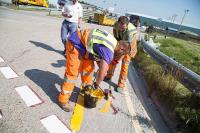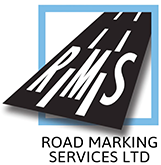 Add My Company
Add My Company
Sign In
WHAT IS THE HISTORY OF ROAD MARKINGS?
02-11-2021

Road markings may seem like they’ve been around forever, however, that’s just not the case. So what is the history of road markings? The first road markings in Sheffield, Leeds, and across the UK were only introduced in 1918, coming in the form of the famous white line. Road markings grew considerably throughout the ‘20s, although it wasn’t until 1926 that office guidelines on their use were introduced by the First Ministry of Transport. Read on to find out more about the history of road markings.
THE INTRODUCTION OF ROAD MARKINGS IN THE UK
What is the history of road markings?
Road markings were introduced in the UK in 1918. White lines gradually became more and more and prominent on the country’s roads. In England, the idea of painting a white line in the centre of the road was first tested in 1921 in Birmingham. The Sutton Coldfield Corporation painted the line on Maney Corner in Maney following complaints by local residents over careless driving and after many collisions.
However, it wasn’t until 1926 that the marking became official. Despite the white line being used on almost all roads, it would take almost a decade to be acknowledged legally. The First Ministry of Transport eventually recognised this road marking.
Road markings became more widely used during the ’30s. White lines were increasingly used as ‘stop’ lines at junctions. The traffic flow on these roads would be controlled by traffic lights or police. This helped to manage the movement of vehicles.
THE INVENTION OF CAT’S EYES
In 1934, cat’s eyes were created by Percy Shaw after an encounter with a cat on a foggy night. They’re often said to be one of the most brilliant inventions ever produced for the benefit of road safety. Placed in the middle of the road, they were intended to aid white lines at night and when visibility was poor, such as on foggy days. The original design of cat’s eyes comprised of two retroflectors fixed to a white dome and mounted on cast iron.
THE RISE OF ROAD MARKINGS THROUGHOUT THE DECADES
Road markings advanced quickly throughout the 1940s and 1950s. By 1944, white lines had started to be used to establish the sides of the roads and keep traffic in the proper lane. The government was urged to make it safer for pedestrians to walk during the blackout in World War II. This led to white lines being painted on the sides of the road. The boundaries between the carriageways and laybys were also marked by white lines.
The 1950s marked the beginning of yellow lines which were designed to communicate restrictions on parking, loading and unloading, and waiting. The intention was to reduce traffic waiting times and to improve pedestrians’ access to pavements. Previously, the loading and unloading of vehicles without any rules or regulations caused significant disruption.
There were more changes in the ‘50s. The UK Government agreed that double white lines would be used to prevent drivers from overtaking on roads on which it was too hazardous to do so.
As cars became more affordable and accessible, the roads became busier, and it came necessary to control the traffic. As a result, yellow box road markings were introduced in 1960. Yellow boxes began appearing on roads across the country at busy junctions.
The Highway Code and the gov.uk website are good places to find detailed information about road markings in the UK.
THE CHANGING DESIGN OF ROAD MARKINGS IN THE UK
Road Markings in Sheffield
In the UK, there are various ways of adding markings to roads. These include painting the information onto the road; applying thermoplastic markings; and using temporary road marking tape. Paint was widely used originally. However, over the years, this has become a less common method. Today, thermoplastic is widely used for many road markings in Sheffield, Leeds, and nationwide. This material is applied whilst it’s hot.
One reason for this is that it’s significantly more durable than paint. This means that it won’t fade as quickly. Markings made from thermoplastic are able to tolerate cars driving over them for several years without diminishing. Thermoplastics can be cut to size before being applied. This can drastically reduce the time and labour needed when marking a road.
Thermoplastic road marking paint consists of a solid powder when at room temperature. A specialised machine called a thermoplastic heater mixer melts the powder. It then moves into the paint tank of a marker.
WHY HIRE ROAD MARKING SERVICES
Road Marking Services has been applying road markings and white lining in Sheffield and Leeds for many years. Our line marking operatives are highly trained and very experienced. This ensures we only ever deliver a high standard of workmanship on every job. We have a fantastic reputation in our industry, with many positive reviews from happy customers.
At Road Marking Services, we’re the UK’s leading thermoplastic markings paint contractors. Our thermoplastic conforms to British standards and is a very high-quality and durable product, conforming to all safety and performance standards. You can rest assured that road markings made from thermoplastic will stay looking clear and accurate for many years to come.
If we can’t use thermoplastic for your project, we can offer a range of other products, including acrylic, MMA paint, epoxy, and rubber paint. If you’re not sure which material right for your needs, simply ask us. We’ve been a main player in the road marking industry for over 25 years, so you can be sure that we can answer all of your questions and queries.
CONTACT US
To talk to one of our friendly team, don’t hesitate to call 0800 086 2509. Alternatively, send us a message via the website. Someone will get back to you as quickly as possible. We can provide a free site visit and no-obligation quotation.
For more information on WHAT IS THE HISTORY OF ROAD MARKINGS? talk to Road Marking Services
Enquire Now
List your company on FindTheNeedle.

